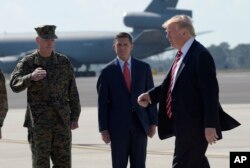On the presidential campaign trail, Donald Trump demurred when asked to outline his war plan to defeat the so-called Islamic State terror group, arguing he wasn’t going to tip his hand to America’s foes by revealing his intentions.
Last Friday, though, President Trump turned to his generals for a detailed military strategy, and he signed an executive order instructing members of his Cabinet and the Joint Chiefs of Staff to come up with a plan within 30 days - one that can be implemented immediately.
Does that mean Trump never had a plan?
Maybe not in tactical detail when it came to a military campaign, but he did outline some broad policy strokes in a speech in August, including combating the ideology of “radical Islam” more effectively, introducing extreme-vetting immigration procedures, moving America away from nation-building and regime change in the Middle East, and engaging in a radical realignment by forging an alliance with Russia to defeat IS and its jihadist rival al-Qaida.
When it came to a war plan, candidate Trump offered just three tactics: intensifying the bombing of the Islamic State, seizing control of oilfields in Iraq, and recruiting NATO to invade strongholds in the Middle East to “knock the hell out of ISIS.”
Flynn's influence
Much of what Trump says about the war on IS has been influenced by a book written by Mike Flynn, a former intelligence general who’s now President Trump’s National Security Adviser.
The question is how much of Flynn’s overall thinking will inform the military strategy that Trump eventually approves. Will there be a grand strategy or just tactical changes from how Barack Obama waged the campaign against IS?
In The Field of Fight, which was published last July and co-authored with conservative historian Michael Ledeen, Flynn offered what he described as “a winning strategy” to defeat IS and al-Qaida, one relying more on military muscle than the technology-driven and drone-strike policy favored by Trump’s predecessor, Barack Obama.
In The Field of Fight, Flynn says the full weight of American power should be brought to bear on the jihadists, much as the United States did in the Second World War to defeat its foes. Flynn also argued for cutting ties with any foreign powers deemed to be assisting the jihadists indirectly or otherwise, including traditional Gulf allies. If the countries sheltering jihadists won’t eradicate them, then American forces should march in and do so, he argued.
An internal administration tussle over strategy is already underway, according to Pentagon officials, who asked not to be identified for this article.
They say Flynn’s NSC team is pushing for a much grander strategy than that favored by the Pentagon, led by another retired general, James Mattis.
Grand strategy
The campaign Flynn envisions would be “similar to the effort during World War II or the Cold War” and he argued in his book that it should be overseen by a single leader answerable to the president. On that idea there’s already push-back, say officials at the Defense Department, who want to move much of the tactical authority for waging the war against IS from the NSC back to the Pentagon.
Pentagon planners say much has changed tactically since Flynn wrote The Field of Fight. The Pentagon claims U.S.-led airstrikes have killed up to 75 percent of IS fighters, including 180 top commanders. The terror group’s ability to replenish itself with foreign recruits has been choked. The so-called caliphate has been shrunk thanks to ground action by allies, including Syrian and Iraqi Kurdish militias and reconstituted Iraqi state forces.
Fighting IS and al-Qaida in the future will require less military muscle and more intelligence-led approaches sustainable over the long haul, say analysts, including former Army Chief of Staff Gen. Raymond Odierno.
Last year, Odierno criticized Trump talk of intensified bombing, arguing “there are limits to military power,” which he suggested can provide only short-term outcomes, but not sustainable ones.
Officials say tactically focused options to accelerate the campaign against IS have been presented by the Joint Chiefs to Defense Secretary Mattis. They say the options include ways to prevent IS fighters from moving between Syria and Iraq and how to oust the terror group from Raqqa.
Information network
Last month at a NATO meeting in Brussels, Marine Corps Gen. Joseph Dunford, chairman of the Joint Chiefs of Staff, said a key aim is to improve intelligence sharing against terror groups and foreign fighters.
"The big thing we want to do is establish an information [and] intelligence network as wide as we can," he said.
Military officials also want an easing of restrictions imposed by the Obama administration on drone and bombing strikes, and the Pentagon wants to increase the number of special forces used in raids and capture missions.
The latter recommendation likely will chime with Flynn’s thinking. He complained publicly last year that under Obama, one of the problems was that the military's hands were tied. As director of intelligence between 2004 to 2007 for the Joint Special Operations Command, the U.S. military’s elite hunter-killer force, Flynn was highly involved in an intelligence-driven strategy in Iraq for capturing and killing suspected terrorists known as “find, fix, finish.











